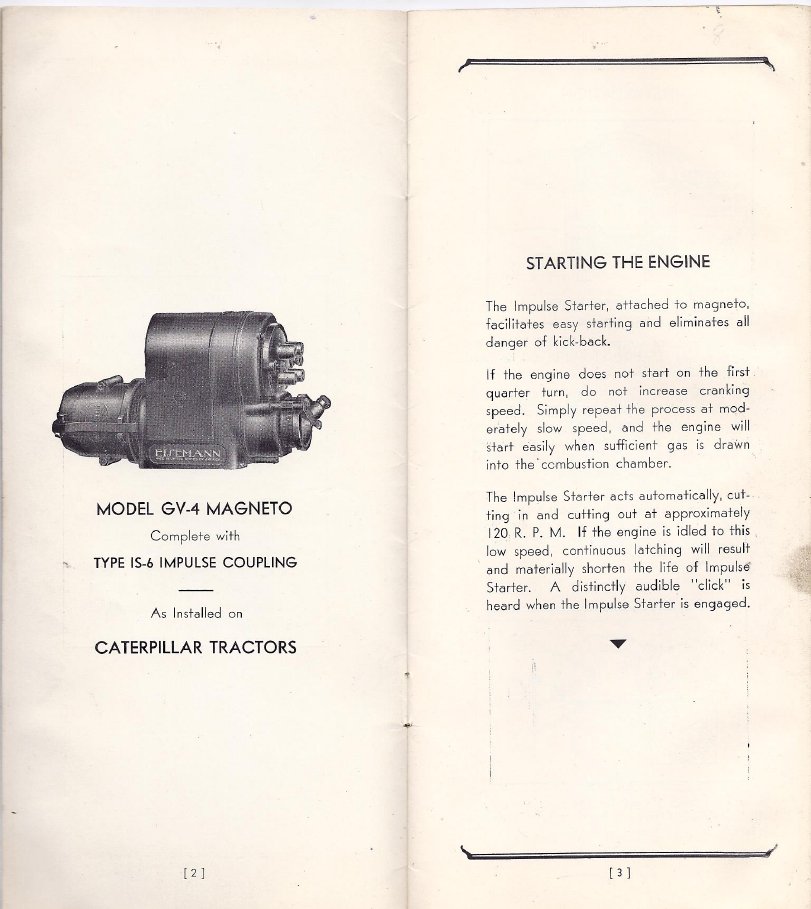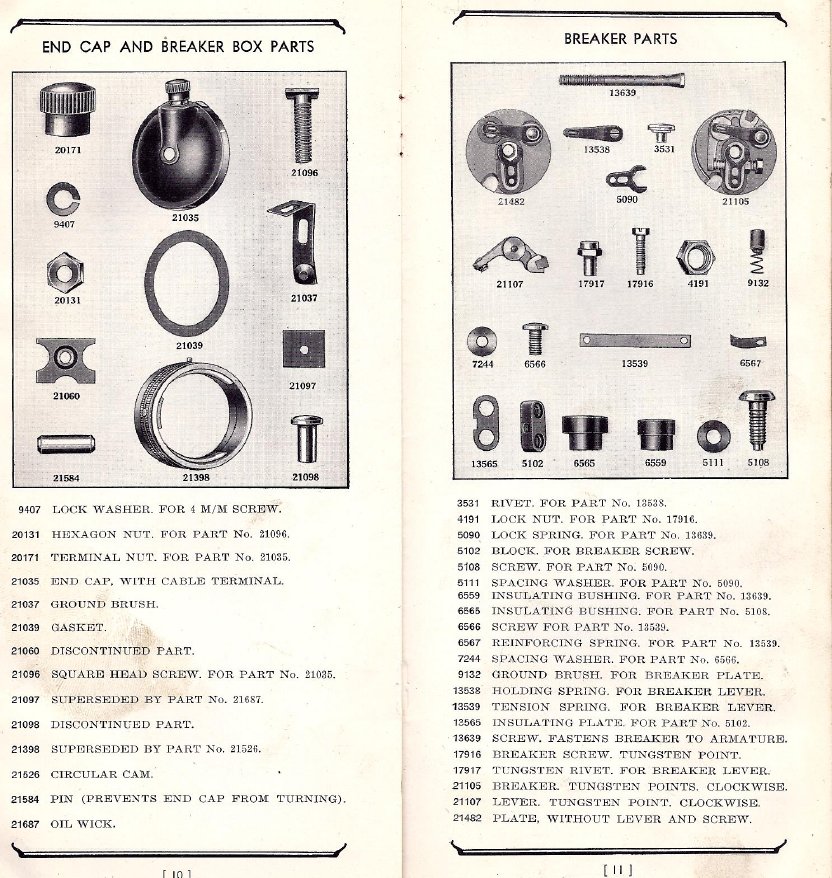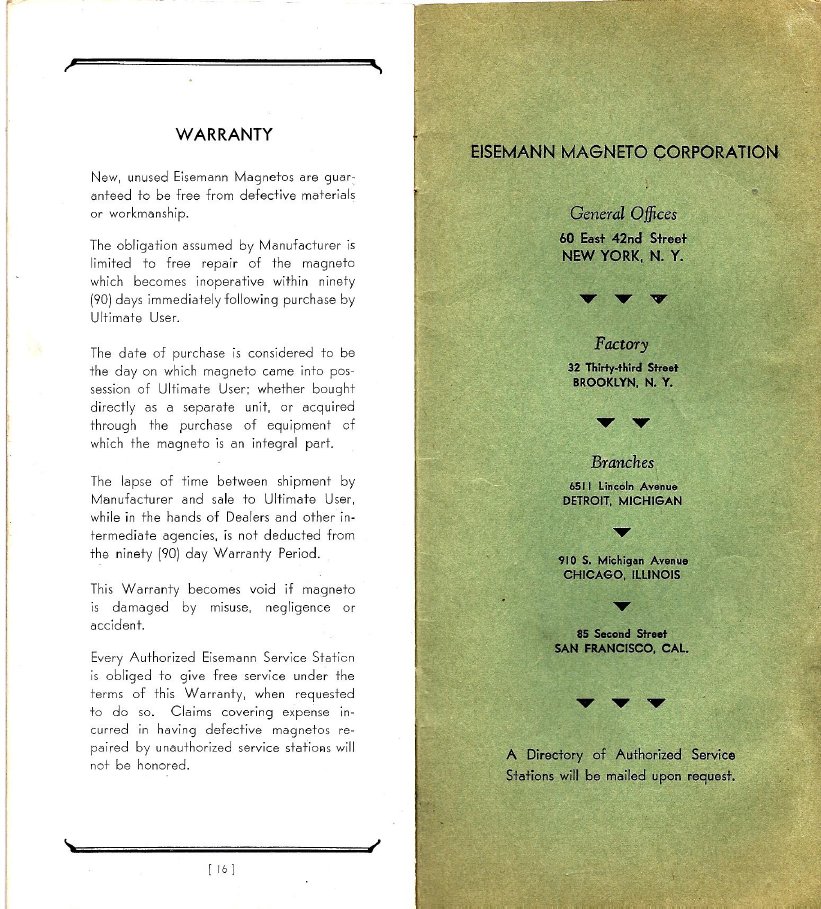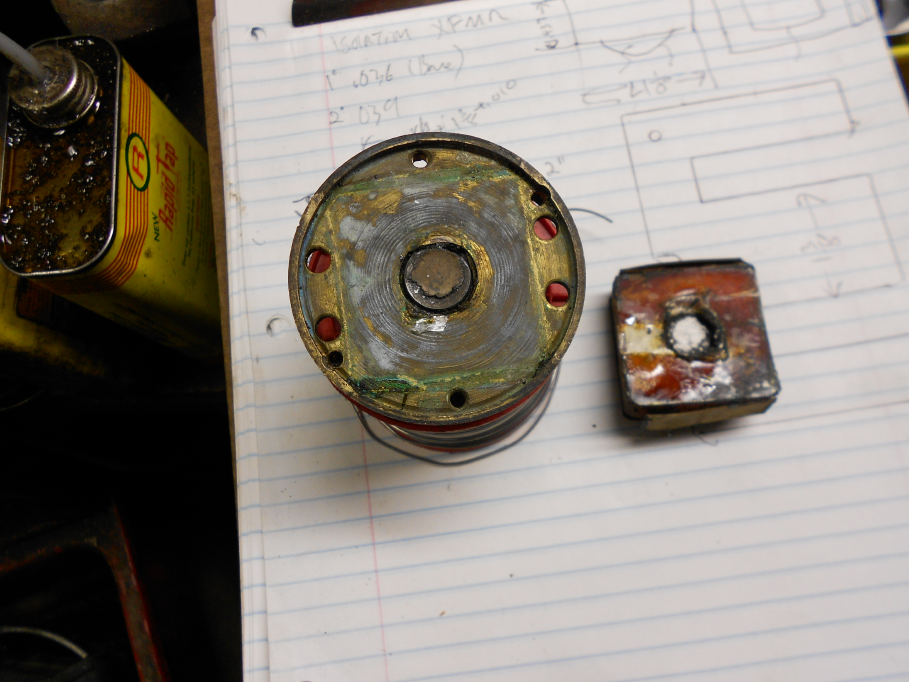There are no products listed under this category.
Shop by Category
-
Wico Magneto RX
- AX Magneto Brochure
- B Magneto RX
- F Series: F,FG,FGM,FGS
- A Magneto RX
- Condenser Information
- EK Magneto Rx
- LD and H Magneto RX
- OC Wico Magneto
- R Magneto Ignitor RX
- XH and XHD Magneto RX
- AH Wico magneto Rx
- AP Magneto RX
- C Magneto RX
- FW Series: Flywheel Magneto Service Info
- H1 Magneto RX
- J4 Manual
- JEM Manual
- PR Magneto RX
- Wico Magneto 1946 Catalog
-
Wico Magneto Application Information
- XVD-4 and XVD-6
- Bendix
- Berling Magnetos
-
Bosch, American Bosch, and Robert Bosch
-
American Bosch
-
Am Bosch Mags Ca 1945 MJA MJB MJC MVA MJK
- MRA Magneto American Bosch
- MRF American Bosch Magneto
- DU1,DU2,DU4..Ad nauseum Bosch Catalog 50
- Flywheel Magnetos by American Bosch
- Impulse Coupler RX
- Instruction Book & Agents 1925 Am Bosch
- Service Manual American Bosch Magneto 1928
- ZR4 For Ingersoll Rand Compressor
- ZR4 ZR6 Instruction Manual
- AB 33 and some mumblings on the AB34
- Application Information
- AT4 AT6 Bosch Magneto Instruction Parts Manual
- B4 + B6 Manual
- Bosch Magneto Service Parts List 1922
- DU Service Manual
- FX1 American Bosch Magneto Parts List
- Home of the Bosch Magneto
- MRD Am Bosch Magneto Service Manual
- MVA American Bosch Magneto Instruction Manual
- U1 U2 U4 U6 Debut Whatsa Matter U?
- ZR4 Service manual
-
Am Bosch Mags Ca 1945 MJA MJB MJC MVA MJK
- Bosch
- Robert Bosch
-
American Bosch
-
Edison Magneto
-
Eisemann
- CM4/CT4 Eisemann Magneto Instructions
-
Flywheel Magnetos by Eisemann
- Eisemann 61-D flywheel magneto
- Eisemann 61Cflywheel Mag
- eisemann 61DA Flywheel magneto
- Eisemann 61DC flywheel magneto
- Eisemann 61DE Flywheel magneto
- Eisemann 61DF Flywheel magneto
- Eisemann 61DH Flywheel magneto
- Eisemann 61NA flywheel magneto
- Eisemann 62-D Flywheel magneto
- Eisemann 72C Flywheel Magneto
- Eisemann 72D Maytag Magneto
- Eisemann 72DA Maytag Magneto Service
- Eisemann 82-D and 82-F Flywheel Mags
- M4G6 Eisemann Magneto Generator
- AM Series
- Automatic Spark Control Early
- CM-4 Caterpillar Magneto Service + Parts Manual
- CT-4 Caterpillar Magneto Service & Parts Manual
- EB
- ED EU EA
- Eisemann Catalog 1920
- Eisemann Catalog with Accessories
- Eisemann catalog 1915
- Eisemann- Caterpillar Parts Info
- EM Dual
- EM for Model T Ford
- G0 G1 G2 Service and Parts Manual
- G4
- GL Series Service & Parts Manual
- GL1 GL2 GLF1 GLF2
- GL4 GL2H
- GN6 Edition 3 Manual
- GN6 Edition 4
- GR4 Ed 2 magneto parts&Service manual
- GS Series
- GV Series Service and Parts Manual
- GV-4 GV-2H GV-2Q
- GV-6 Eisemann magneto
- RC/RT Series
-
Fairbanks Morse
- Fairbanks Morse Illustrated parts 1983 Sec 4
- Fairbanks Morse Magneto Application Information
- Fairbanks Morse Model "R" RX
- FM FM-H FM-K FMO FM-OH Heavy Duty Series RX
- FM-J1A.. FM-J1B.. Radio Shld 9864A
- FMJ Series Parts List 1947 Bulletin 9846B
- FMJ1A Instructions 1947 Bulletin 2888B
- FMJ1A.. FMJ1B.. 1947 Bulletin 2864B
- FMJ2 Series 2854C
- FMJ4A,B Instructions 1942 Bulletin 2846A
- FMJH Series: Mercury/Disston/Kiekhafer 9871A
- FMJV4B Wisconsin V4 Engine
- FMX. Series: AKA the Updated FMJ series
- Magnetizing Fairbanks Morse Magnetos
- RV RX
- Heinze AX & BX Magneto
- Ignition and Truck Profits
- International Harvester Magneto Rx
-
K-W Ignition Company Magnetos
- K-W Ignition Magneto Instruction Book 3Rd Ed
- K-W Low tension Magnetos catalog 19
- K-W Model J Magneto Manual
- K-W Model T and TK Magneto Instruction Book
- K-W O F Oscillating Magneto Manual
- K-W T TK TU TUK Magneto Catalog Ed 8
- K-W T TK TU TUK Magneto Manual Edition 6
- KW Magneto Promo What Makes Tractor Go?
- Perfection Magneto Company
- Pittsfield type B Magneto
- Remy
- Simms Magneto
- Simms Motor Units Catalog 1940
-
Splitdorf
- C Magneto Specifications
- C Magneto manual
-
Dixie and Aero Magnetos
- Dixie 46 246 462 Magneto Parts List
- Aero 448 449 648 649 Magneto
- Aero AE Magneto Manual
- Aero Magneto Catalog 1925
- Dixie 235 Oscillating Magneto
- Dixie 40 42 and 44 Magneto Manual N-404A 1919
- Dixie 46 Magneto Manual N-403C 1919
- Dixie 8 Cylinder Magnetos #83-86
- Dixie Aero Service Info
- Dixie Magneto Model 60 and 63 Catalog 1915
- Dixie Splitdorf Magneto Catalog N-401
- Splitdorf 46T and EM Impulse Starter
- Splitdorf Dixie M1 & M2 Magneto
- NS-1-2550 Magneto parts List
- NS-2 Magneto Parts list
- NS-4 Magneto parts List
- S-2 Magneto Parts List
- S-4 Magneto parts List
- SS-4 Magneto Parts List
- SS-6 Magneto Parts List
- SS-6-2 Magneto Parts List
- SSO Magneto Parts List
- AE
- Cross Country On Motorcycle
- NS Motorcycle Magneto Manual
- S NS SS B Magneto Service Manual
- Splitdorf Apelco Starting Lighting
- Splitdorf catalog 1910
- Splitdorf catalog 51 1913
- Splitdorf Magneto catalog 52 1914
- Splitdorf Magneto catalog 53 Models EU & EV
- Splitdorf Magneto catalog 57 1914
- Splitdorf Wiring Diagrams 1914
- U & V Splitdorf Magneto manual 1912
- Sumter Magneto Rx
- Webster
-
Wico Magneto RX
- AX Magneto Brochure
- B Magneto RX
- F Series: F,FG,FGM,FGS
- A Magneto RX
- Condenser Information
- EK Magneto Rx
- LD and H Magneto RX
- OC Wico Magneto
- R Magneto Ignitor RX
- XH and XHD Magneto RX
- AH Wico magneto Rx
- AP Magneto RX
- C Magneto RX
- FW Series: Flywheel Magneto Service Info
- H1 Magneto RX
- J4 Manual
- JEM Manual
- PR Magneto RX
- Wico Magneto 1946 Catalog
- Wico Magneto Application Information
- XVD-4 and XVD-6
- Bendix
- Berling Magnetos
- Bosch, American Bosch, and Robert Bosch
- Edison Magneto
-
Eisemann
- CM4/CT4 Eisemann Magneto Instructions
- Flywheel Magnetos by Eisemann
- M4G6 Eisemann Magneto Generator
- AM Series
- Automatic Spark Control Early
- CM-4 Caterpillar Magneto Service + Parts Manual
- CT-4 Caterpillar Magneto Service & Parts Manual
- EB
- ED EU EA
- Eisemann Catalog 1920
- Eisemann Catalog with Accessories
- Eisemann catalog 1915
- Eisemann- Caterpillar Parts Info
- EM Dual
- EM for Model T Ford
- G0 G1 G2 Service and Parts Manual
- G4
- GL Series Service & Parts Manual
- GL1 GL2 GLF1 GLF2
- GL4 GL2H
- GN6 Edition 3 Manual
- GN6 Edition 4
- GR4 Ed 2 magneto parts&Service manual
- GS Series
- GV Series Service and Parts Manual
- GV-4 GV-2H GV-2Q
- GV-6 Eisemann magneto
- RC/RT Series
-
Fairbanks Morse
- Fairbanks Morse Illustrated parts 1983 Sec 4
- Fairbanks Morse Magneto Application Information
- Fairbanks Morse Model "R" RX
- FM FM-H FM-K FMO FM-OH Heavy Duty Series RX
- FM-J1A.. FM-J1B.. Radio Shld 9864A
- FMJ Series Parts List 1947 Bulletin 9846B
- FMJ1A Instructions 1947 Bulletin 2888B
- FMJ1A.. FMJ1B.. 1947 Bulletin 2864B
- FMJ2 Series 2854C
- FMJ4A,B Instructions 1942 Bulletin 2846A
- FMJH Series: Mercury/Disston/Kiekhafer 9871A
- FMJV4B Wisconsin V4 Engine
- FMX. Series: AKA the Updated FMJ series
- Magnetizing Fairbanks Morse Magnetos
- RV RX
- Heinze AX & BX Magneto
- Ignition and Truck Profits
- International Harvester Magneto Rx
-
K-W Ignition Company Magnetos
- K-W Ignition Magneto Instruction Book 3Rd Ed
- K-W Low tension Magnetos catalog 19
- K-W Model J Magneto Manual
- K-W Model T and TK Magneto Instruction Book
- K-W O F Oscillating Magneto Manual
- K-W T TK TU TUK Magneto Catalog Ed 8
- K-W T TK TU TUK Magneto Manual Edition 6
- KW Magneto Promo What Makes Tractor Go?
- Perfection Magneto Company
- Pittsfield type B Magneto
- Remy
- Simms Magneto
- Simms Motor Units Catalog 1940
-
Splitdorf
- C Magneto Specifications
- C Magneto manual
- Dixie and Aero Magnetos
- NS-1-2550 Magneto parts List
- NS-2 Magneto Parts list
- NS-4 Magneto parts List
- S-2 Magneto Parts List
- S-4 Magneto parts List
- SS-4 Magneto Parts List
- SS-6 Magneto Parts List
- SS-6-2 Magneto Parts List
- SSO Magneto Parts List
- AE
- Cross Country On Motorcycle
- NS Motorcycle Magneto Manual
- S NS SS B Magneto Service Manual
- Splitdorf Apelco Starting Lighting
- Splitdorf catalog 1910
- Splitdorf catalog 51 1913
- Splitdorf Magneto catalog 52 1914
- Splitdorf Magneto catalog 53 Models EU & EV
- Splitdorf Magneto catalog 57 1914
- Splitdorf Wiring Diagrams 1914
- U & V Splitdorf Magneto manual 1912
- Sumter Magneto Rx
- Webster
GV-4 Caterpillar Eisemann Magneto Rx
The Eisemann GV was begat after the famous G.. series, like the G4. It was not as massive and robust but was not plagued by the usual potmetal issues. It was standard equipment on many gas powered Caterpillars as well as some Allis Chalmers and Kohler light plants. Some 2 cylinder versions were used on gas pony motors on early diesel tractors. They were actually an excellent mag with proper care, smaller, but hot. Beware of insulation seepage. They like any wound armature are very subject to sticky goo. Their brass armature endcaps have the steel driveshaft molded in and are more fragile than the larger G series. If it gets gooey, it is time to rewind. Here are some tips to help keep yours well. The manual specifies a plug gap of 1/32" and of course non resistor plugs and solid wires. The points should be set at about .012-.014" or .3-.35MM. The nut and adjusting screw as well as the screw that holds the points in are metric sizes.
The GV and GS series used a lot of 4mmx.75mm threads (Not the standard metric 4MMx.7) inside for their safety gap screw, timing pointer,armature end caps and 10-32 threads on the outside. There are also metric threads lurking in some of the later Eisemann magnetos as well.
These images are from the Eisemann Caterpillar application service manual.



Note how plug wires are to be connected. Mr Eisemann did not make it easy.
There were some later versions fo the GV4 that had taller distributor posts and would accept the common plug in wire ends.

Always be sure that the mag impulse coupler does not crowd against the float and the tractor drive hub as described above. This will stress the impulse coupler and may cause the impulse to not engage and retard the spark when starting causing an armbreaker.




Your mag is probably out of warranty.

Sticky goo from deteriorated insulation varnish.

This is one that suffered from sticky goo from deteriorated armature insulation and got a mighty crank. The shuttle pole shoes were glued to the stationary poleshoes and the steel driveshaft turned in the brass endcap and dug into the condenser.

